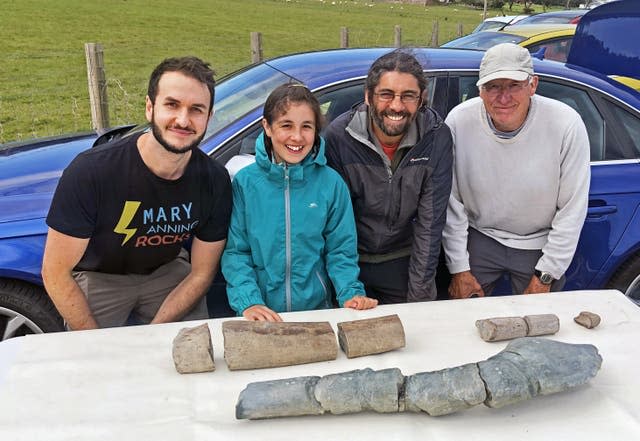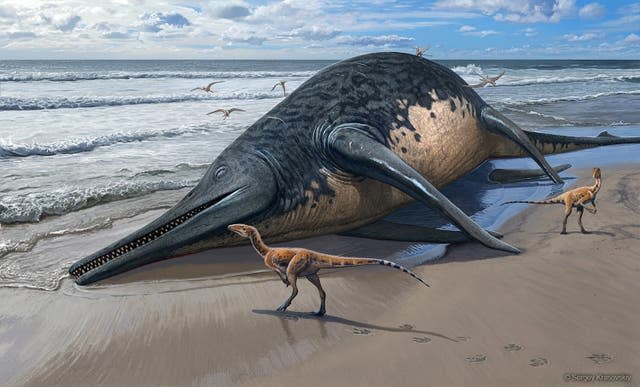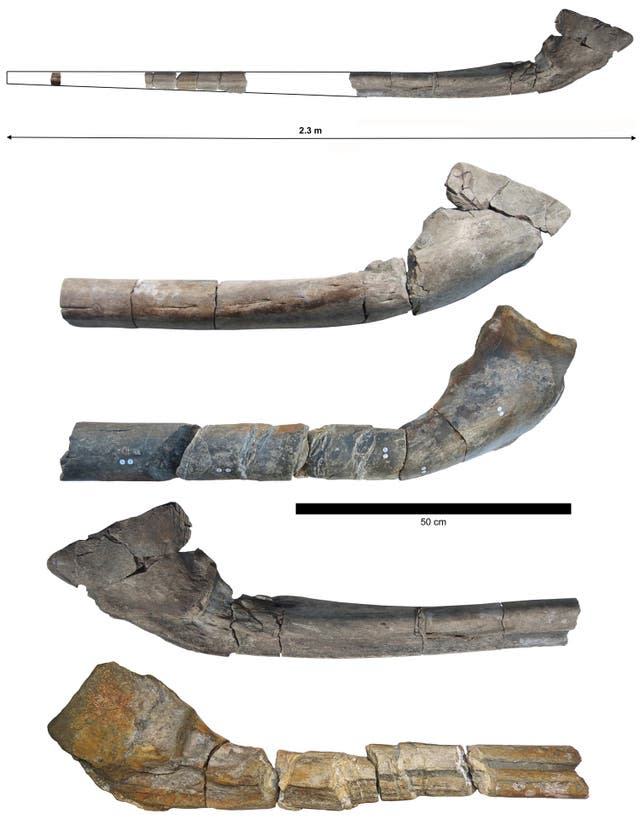Researchers identify ichthyosaur that may be the largest known marine reptile
Palaeontologists have identified what may be the largest known marine reptile.
A father and daughter found the fossilised remains of a gigantic jawbone measuring more than two metres long on a beach in Somerset.
The bones belong to the jaws of a new species of enormous ichthyosaur, a type of prehistoric marine reptile.

Experts estimate that the giant creature would have been more than 25 metres long.
They believe the specimen represents possibly the largest marine reptile ever recorded
In May 2020, Justin and Ruby Reynolds from Braunton, Devon, discovered the first pieces of the second jawbone while hunting for fossils on the beach at Blue Anchor.
Ruby, then aged 11, found the first chunk of giant bone before the duo searched together for more pieces.
Realising they had discovered something significant, they contacted Dr Dean Lomax, a palaeontologist at The University of Manchester.
Dr Lomax contacted Paul de la Salle, a seasoned fossil collector who had found the first giant jawbone in May 2016 from further along the coast at Lilstock.
Mr Reynolds said: “When Ruby and I found the first two pieces we were very excited as we realised that this was something important and unusual.
“When I found the back part of the jaw, I was thrilled because that is one of the defining parts of Paul’s earlier discovery.”
Ruby added: “It was so cool to discover part of this gigantic ichthyosaur. I am very proud to have played a part in a scientific discovery like this.”

Dr Lomax, said: “I was amazed by the find. In 2018, my team (including Paul de la Salle) studied and described Paul’s giant jawbone and we had hoped that one day another would come to light.
“This new specimen is more complete, better preserved, and shows that we now have two of these giant bones – called a surangular – that have a unique shape and structure.
“I became very excited, to say the least.”
He added: “I was highly impressed that Ruby and Justin correctly identified the discovery as another enormous jawbone from an ichthyosaur.
“They recognised that it matched the one we described in 2018. I asked them whether they would like to join my team to study and describe this fossil, including naming it.
“They jumped at the chance. For Ruby, especially, she is now a published scientist who not only found but also helped to name a type of gigantic prehistoric reptile.
“There are probably not many 15-year-olds who can say that. A Mary Anning in the making, perhaps.”

Over time, the team – including the father-daughter duo – found more pieces of the same jaw which fit together perfectly, like a multimillion-year-old jigsaw.
The last piece was discovered in October 2022.
Led by Dr Lomax, the researchers revealed that the jawbones belong to a new species of giant ichthyosaur that would have been about the size of a blue whale.
The team named the creature Ichthyotitan severnensis, which means giant fish lizard of the Severn.
Dating to the end of the Triassic Period in a time known as the Rhaetian, the bones are around 202 million years old.
Gigantic ichthyosaurs swam the seas during this time, while the dinosaurs walked on land.
But rock and fossil records suggest that after the Late Triassic global mass extinction event giant ichthyosaurs became extinct, meaning the bones discovered in the study represent the very last of their kind.
Master’s student, Marcello Perillo, from the University of Bonn, Germany, carried out further investigations and found that the animal was still growing at the time of death.
He said: “So much about these giants is still shrouded by mystery, but one fossil at a time we will be able to unravel their secret.”
Concluding the work, Mr de la Salle added: “To think that my discovery in 2016 would spark so much interest in these enormous creatures fills me with joy.
“When I found the first jawbone, I knew it was something special. To have a second that confirms our findings is incredible. I am overjoyed.”
The new research is published in the journal Plos One.

 Yahoo News
Yahoo News 
